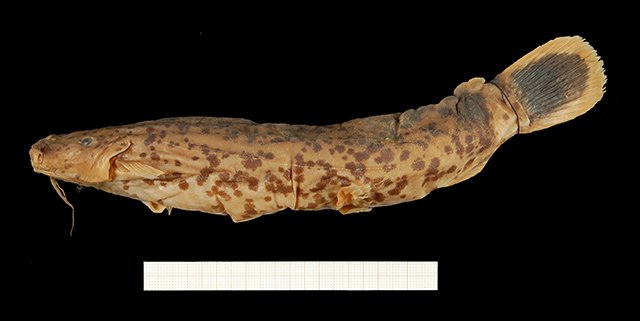| Malapteruridae (Electric catfishes) |
| 24 cm SL (female) |
|
benthopelagic; freshwater, |
| Africa: Cess (=Nipoué) and Cavally rivers in Western Ivory Coast (Ref. 44050, 57130). |
|
Dorsal spines (total): -0; Dorsal soft rays (total): -0; Anal spines: -0; Anal soft rays: 7-9; Vertebrae: 38-41. Diagnosis: tooth patches broad, semi-circular; pectoral fins placed low on body; 7-9 anal-fin rays; 20 caudal-fin rays (arrangement ii-7-8-iii, rarely ii-7-8-ii); 1-2 gill-rakers on upper branch of first arch; 38-41 vertebrae; caudal saddle and bar strongly developed; caudal saddle generally composed of concentrations of spots and blotches; caudal bar confined to base of caudal fin, not extending onto the caudal peduncle; body brown or tan; caudal fin darkly and solidly pigmented without pale basal crescent; lower lip, underside of head and mental barbels unpigmented or lightly pigmented (Ref. 44050).
Description: body and head strongly depressed; eyes small and dorsolaterally directed; lower jaw distinctly prominent; 16-18 abdominal vertebrae; 22-24 caudal vertebrae (Ref. 44050, 57130). 20 caudal fin rays (arrangement ii-7-8-iii)(Ref. 57130).
Coloration: body and head bicolored; dorsum and flank light brown; venter tan; flank and dorsum well spotted with coarse, frequently overlapping spots and blotches, many up to 3-4 times an eye diameter; spots continue on venter but not as densely; paired fins unspotted, pectoral fin clear, pelvic fin opaque-whitish; dorsal surface of paired fins in adults may be lightly colored with flank pigment; anal fin occasionally bears spots and generally has a darkly pigmented basal portion (not always well-defined), which is usually confined to posterior half of fin; caudal fin darkly pigmented throughout with a well-defined pale distal margin; caudal bar with vertical and straight anterior margin, largely confined to the caudal fin; caudal saddle mottled, appearing as a series of closely set blotches and spots, extending ventrally across 2/3 of the flank to just below the level of the lateral line and never onto the anal fin; saddle extends onto anterior half of adipose fin, the posterior half of which matches the pale interspace; saddle fades with increasing body size (Ref. 44050). |
|
|
Near Threatened (NT); Date assessed: 02 February 2007 Ref. (130435)
|
| harmless |
Source and more info: www.fishbase.org. For personal, classroom, and other internal use only. Not for publication.

